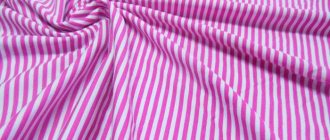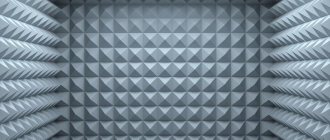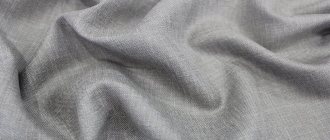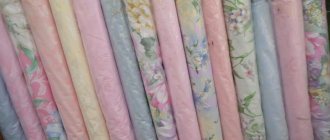Good afternoon to everyone who has visited my website, where I share everything that is “sewn together with back-breaking labor.” Today we are talking about duplicating parts when sewing clothes . I will try to tell you about all the rules, tricks and subtleties that I know.
We will remember the rules of heat setting, that is, duplicating clothes using adhesive methods. Glueless duplication is a big complex topic in which I am definitely not an expert. My “respect and deep respect” to those who own the technology. For us, in order to sew with dignity, it is enough to know the rules for handling glue stocks. Moreover, the choice of thermoplastic materials on the market (dublerins, non-woven fabrics) suits every taste and budget.
Hot-melt adhesive gasket materials
I don’t pretend to give a complete review, but I’ll go over the main positions that I use myself.
- Doublerin - This is an ordinary fabric, on one side of which a layer of glue is applied. Dublerins differ in density, base composition, extensibility, as well as the nature of application of the adhesive coating (height and frequency of glue dots). I mainly use duplerins: -collar, not too dense - thin and stretchable on a knitted basis. This is the number one stock in my workshop. Invisible, flexible, does not spoil the properties of the base, and at the same time helps to keep its shape. Improves the appearance of the most unsightly matter. Chiffon duplerin from Hensel is my main assistant. Expensive, but worth the money. - with a base like gauze. I also buy German-made ones, they are cheaper than knitted ones and are denser. I strengthen coat parts, sometimes the sides of jackets.
dublerin on a knitted chiffon base Hensel
cotton-based dublerin
Hensel double collar collar - woven interlining is a non-woven cushioning material with an adhesive coating. It comes in different thicknesses and densities. Thread stitched and simple. I rarely use non-woven fabrics, mainly in shirt trims or dress collars, and even then I prefer double fabric on a chiffon base. I will choose non-woven fabric if I am making a product from inexpensive fabric. I only buy thin thread stitching. Non-woven edges . There are thread-stitched and simple ones. Application: duplicating cuts, seams.
- Excellent material, comfortable, but expensive. In order to save money, I cut strips of the required width myself from the materials that I have on hand.
- Adhesive corsage tapes . This is a material for making belts. Available in different widths, single or double, with perforation along the edge, which makes marking easier and allows the belt to be perfectly straight.
- Glue webs and meshes. It's just a layer of glue, no backing. They completely kill the plasticity of the fabric, making the part “wooden”. Never buy or use them. If they are still present in your workshop, then find them and throw them away, so God forbid they stick somewhere.
corsage adhesive tape
non-woven thin
thread-stitched interlining
The most common question that arises when duplicating is: what parts should I duplicate? There are a lot of subtleties here, and in one case we will duplicate the same detail, but not in another. To understand WHAT to strengthen, you need to understand WHY. It’s like in any problem: when you understand the essence of the process, you don’t need to memorize the solution algorithm - you yourself will build it in the best possible way without any hints.
Adhesive cushioning materials are available in woven and non-woven forms.
Often adhesive fabrics and non-woven materials such as non-woven fabrics are simply called “adhesive”. But this is too general a concept, and in a hardware store, sellers will ask you to clarify what you need, non-woven or double-lined. Adhesive fabric pads, just like regular fabrics, have a fractional thread direction, and to be precise, they are called fabric-based dublerin. Non-woven adhesive materials are called interlining. It's easy to distinguish them. Dublerin stretches when torn, and non-woven fabric tears like paper.
Dublerin has the direction of the grain thread, so when cutting you need to take this circumstance into account and be sure to pay attention to the recommendations in magazines for ready-made patterns. And if you use your own patterns, then you need to take into account the properties of the gasket for each section of the product separately. Non-woven gaskets are a pressed mixture of fibers, due to which the sections do not fray
However, even in such gaskets there is a fiber direction. Along the longitudinal web, the gasket stretches slightly less than in the transverse direction.
Non-woven pads are a pressed mixture of fibers, so that the sections do not fray. However, even in such gaskets there is a fiber direction. Along the longitudinal web, the gasket stretches slightly less than in the transverse direction.
There are also knitted adhesive fabrics of varying thickness and stiffness. They are elastic and are used for duplicating knitted materials.
Adhesive fabric and non-woven materials come in different densities. From thin and almost transparent to very dense. They can even be painted in different colors.
Why duplicate the details of outerwear.
- To give shape to products (coats, jackets). As the amazing master (and my friend) Svetlana (Milo) says: “A glued shirt is a raincoat, and an unglued jacket is a shirt.”
- Maintain the shape (style) of clothing during use (coats, jackets).
- Protect cuts from stretching (pockets, hems, armholes, neckline)
- make fabrics resistant to creasing (collars, cuffs)
- increase elasticity in places of constant deformation (collars). So, we duplicate it for beauty, reliability and durability. Illustrations from the textbook “Fundamentals of sewing technology”, 2001. author Trukhanova A.T.
What clothing items need to be duplicated?
- In outerwear, they are completely duplicated : shelves, hems, top collar, collar, flaps, leaves. Our goal is to give and maintain shape.
- Zonal (partial) duplication : sides of shelves, side parts of shelves, pocket entrances, slots. This provides extra rigidity to give shape and prevent stretching.
- Duplication of stretch cuts : bottom of product, bottom of sleeves, cuts of armholes, necks, entrance to pockets. At this stage, “turn on” your instincts. This point cannot be applied “directly and head-on”. In coats and jackets, definitely yes, we strengthen the cuts additionally. But not always in dresses. You need to feel whether it is worth making the bottoms heavier, whether it is worth reducing the plasticity of the cuts and increasing the thickness of the seams.
- Duplication is carried out before grinding down the parts.
- The direction of the lobes of the main fabric and the heat-fixing pads must match.
- As a rule, parts from the interlining are cut out without seam allowances, exactly according to the size of the pattern. Visual diagrams for duplicating clothing parts: Let's focus on these general rules and not get confused in the exceptions. Because dublerins are now produced in such a wonderful assortment that you won’t find a share in every one.
duplicating the front of the jacket
duplication of women's jacket
front duplication of the front of the jacket, zonal duplication of the pocket entrance, additional duplication of the bottom and vents of the jacket.
Types of material
Dublerin - what is it? What types is it divided into? Dublerin is a material with cushioning properties. It can be of several types.
Dublerin adhesive is distinguished into types. The types depend on the product specification. It can be with sizing on both sides or without it.
Sizing is a special layer that is applied to dublerin. This composition has a glue base, which is dried in a special way. If this layer is exposed to water or high temperature, it will take on a viscous state. After which the dublerin will stick to the other material. Also, cushioning material varies in strength. It depends on the composition of the material and the amount of glue that is applied to the fabric.
There are 3 main types of dublerin fabric:
- One of the most reliable is the one that has a fabric base. It is used in sewing products such as hats, bags, fur and leather products. This cushioning material is made from dense fabric onto which an adhesive base is applied.
- Brushed knitted material. This type of interlining fabric is not as rigid as the first. But it is also quite durable. It is mainly used as interlining fabric when sewing outerwear. Another area of application for brushed dublerin is a soft toy. The peculiarity of this type of cushioning fabric is that it stretches well in different directions. This property is worth considering when using it.
- Dublerin is elastic. This type of fabric can stretch in all directions. It is easy to use and is used for sewing items such as dresses, blouses, skirts, etc. If the product is sewn using dublerin, it will last a long time. Moreover, it can be washed as many times as needed.
Tricks and subtleties of duplication. My experience.
- I cut out parts from thermal butt without seam allowances, exactly according to the patterns. But I lay the stitching line so that the double linen gets 1 mm into the seam. Exception: collars and cuffs.
- I duplicate the details after fitting, not before. First, I specify the shape, proportions and size of the product that suits me and the customer, then I unrip it, adjust it, and only then strengthen the parts with gaskets.
- I do several tests on pieces of material with different types of thermodublerins. I choose the best.
- For fasteners (loops, buttons, zippers) I always duplicate the material, by default.
- I always duplicate facings (except for bias tapes, of course), I prefer thin knitted doublestitches.
- In shirts and blouses: trims, collars, cuffs
- in dresses: facings, small details (cuffs, valves), collars, fasteners.
- in knitwear: sometimes the cuts are too stretchy. Shoulder - often. Depending on the properties of the knitwear and what I want to get from the product.
- in trousers and skirts: belt. Skirts have a slit.
- entrance to pockets (except patch pockets) from stretching with the edge “along the lobar”
- I regret the iron: glue from thin dublerins can penetrate outward. I use a thin dry iron, place it with the same side up and wash it often.
- There is no need to “carry” the iron over the surface. Place on the surface, press and count to yourself for up to 10 seconds. Then move the iron to the next duplicated area.
- There is no need to wash or wet adhesive dublerins. This is a completely useless activity in the realities of our days. Manufacturers have learned to make applied materials of amazing quality, and the topic of their shrinkage has become a thing of the distant past. Once again: in my practice, I have never encountered shrinkage of adhesive dublerins.
- I buy dulerins only on a natural basis - cotton, viscose.
- No need to skimp on the stock. Poor-quality, inferior adhesives can “kill” the entire appearance of the product, and reduce your work to “nothing” after the first wash. I have long made it a rule to buy good German thermal butts, more often with a thin knitted base. They are expensive now, yes. I don’t throw away the inter-curve lunges, but collect them in a bag - they are always useful later for zonal duplication or for fixing crumbling edges.
- Do you want to sew well? Never use adhesive webs or meshes. Dot.
- The question that remains open for me is whether to use steam during the duplication process. Previously, I used a steam and wet iron, but after a conversation with a Hensel specialist, who categorically rejected steam, I am practicing duplication without steam. The difference is not obvious, I continue comparisons and experiments.
Your opinion may not coincide with the opinion of the editors, represented by me, and that’s okay.
duplication of the upper cuff
duplication of collar and stand
strengthening the neckline on fraying fine wool
Not long ago I was very lucky to visit a warehouse, talk, and even write down great advice from the leading manager of the trading company Hensel. People of Kiev, for the riches of thermal butts, come here: Kiev, st. Gorky, 16 (not advertising). All dealer center specialists are trained in Germany, so these tips come directly from the manufacturer, which is very valuable.
Hensel's Duplication Rules
- Maintain the directions of the grain threads both in the fabric and in the duplerin.
- Duplicate on a hard surface
- The duplicated part should freeze. To do this, leave it on a hard surface for 15 minutes.
- If you have withstood the duplication modes at the beginning, then after that any steam operations, dry cleaning, anything you like are possible.
- Try different duplicating materials on the same fabric. Selecting the correct dublerin requires testing. Try it on a piece: are you satisfied with such density and rigidity? Or do you need a more plastic part?
- Manufacturers offer different thermal dublerins. Pay attention to the adhesive layer: large dots, fine-grained dots, high-head dots, conical dots - all materials are different and intended for different fabrics.
- Loose fabrics: choose a rare point, but high. A drop of glue enters the fibers of the material, penetrates and is fixed. If you take a fine-grained point, it will only catch the top fibers and will not attach securely.
- Question: – what to do if you need to tear off the doublerin? Answer: - spray with steam, soften, peel off, and then clean off the glue with alcohol.
- We duplicate for 16 seconds or 20 seconds, for different types of dubbing. Time must be taken!
- Don't use steam! Dry hot iron only.
- Question: – How to duplicate collars and cuffs? Answer: – for collar workers, the conditions for duplication are very strict. In factories for the production of shirts, special presses are installed. What can be done in a small workshop without special equipment: The surface must be absolutely flat and hard. An ironing board is not suitable, a dining table is better. The iron needs to be heavy. Press down for 25 seconds with all your weight. Make sure that the iron does not burn. Yes, not every material can withstand it, and in 25-30 seconds the fabric can be scorched. Place thin paper on the duplicating layer. No steam!
- Special tape doublers are convenient for making belts. Single - for men's, because they use a grosgrain ribbon. And double women's.
I thank manager Irina for the amazing tour of the warehouse; I really regret that I turned on the recorder late and didn’t take my camera with me. I leave with a bag full of bundles and bags. Now I duplicate collars according to all the rules.
To be honest, after talking with a “specially trained person” I was somewhat surprised. I learned so many new things for myself, it was like I had gone through a reboot. I don’t use steam now; I press the iron on a table covered with cloth and count to 16 seconds. I'm as happy with the results as an elephant!
Your experience will add to the topic of duplication if you leave a comment. There is very little material on adhesives on the Internet, but the topic is extremely important. Correct duplication can change the appearance of the product to “excellent”, and inept duplication can “kill” it. Let's clarify the situation). I wish you all happy sewing!
How to glue a patch with an iron
There are two options for gluing a patch to fabric.
If your patch already contains an adhesive base, proceed as follows:
- The material on which we will glue the patch must be placed and properly straightened on a hard surface so that there are no creases.
- Heat up the iron and turn off the steam option.
- We remove the protective film from the applique and place it face up on the place where we plan to glue the patch. If the thermal patch is large, it is better to secure it to the fabric with pins.
- Cover the top of the patch with gauze or paper and press firmly with an iron. Iron for 30 seconds. To glue the part well.
- We wait 2 minutes and repeat the operation from the wrong side.
We recommend watching the video instructions:
If your patch does not have an adhesive base. No specialized equipment is needed to glue such an applique. For this we need thermal film
When choosing thermal film, you need to pay attention to the types of adhesive base
There are several types of glue:
- Polyamide glue. It has high elasticity and sticks in steam mode. It tolerates washing and dry cleaning well. But it holds less firmly on synthetic fabrics with special impregnations.
- Polyethylene glue is compatible with a wide range of fabrics and is suitable for gluing small parts. Glues without steam.
- Polyester glue is more suitable for synthetic fabrics. Glues without steam. Reacts well to washing and dry cleaning.
So, to glue such a thermal patch:
- Take thermal film of the required size. Apply the glossy side to the applique from the wrong side.
- Heat the iron and iron it through paper or gauze with the matte side of the thermal film facing up.
- Trim off the excess thermal film along the edge of the patch. And check how tightly it is adhered to the patch. Try peeling off the film. She must sit tight.
- If everything is in order, repeat the steps from the first point.











